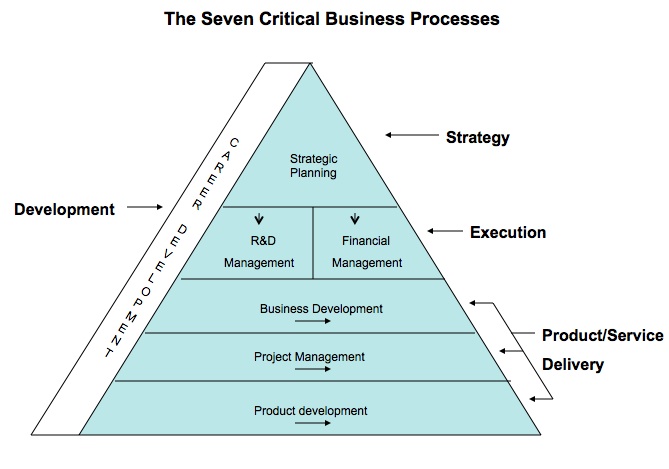Organizations whose main focus is R&D present unique leadership challenges. I have previously defined leadership in terms of the Performance Trilogy® consisting of three distinct roles: developing and communicating a winning strategy (leading); flawlessly executing the strategy (management); and ensuring the performance and development of the staff responsible for doing the work (coaching).
Let’s address these three roles one at a time and discuss why leading R&D organizations is so unique. When developing a strategy in most organizations, innovation is a highly desirable element but not essential for its success. Depending on the industry, R&D budgets range from 0% to 3% of revenues. In R&D organizations (e.g. Bio-pharma, medical products, information technology) innovation is a matter of survival and R&D budgets are often 5% to 10% of revenues. Indeed, there are over 2000 public and private global research institutions whose entire business is R&D. 80% to 100% of their revenues are derived from conducting R&D and providing advice to their government and industrial clients based on sound science. Combine this with the fact that new product life cycles for technology-based companies have been reduced from 7-10 years to 18 months in many cases and it is easy to understand the difficulty in developing a winning strategy based on technology.
In executing their strategy, R&D organizations utilize similar business processes widely taught in business schools. However, the application of some of these processes is once again fairly unique, particularly managing the R&D process. The R&D process involves creating organizational value through research, development and exploitation of science and technology that increases revenues, reduce costs and minimize risks. In this STILE point, I will introduce the seven critical business processes that need to be mastered to successfully manage an R&D organization.
The third phase of the Performance Trilogy® may be the hardest of all to lead; ensuring the performance and development of scientists and engineers executing each of the critical business processes and doing the work. I have often been quoted as saying that “If you can lead scientists and engineers you can lead anyone”. I mean this as a complement. Scientists and engineers by their very nature and training are taught to be skeptical. The peer review process demands that every new idea or concept be thoroughly examined and critically challenged before acceptance. Convincing scientists and engineers requires strong evidence that your strategy is desirable, achievable and beneficial to them. This oftentimes leads R&D managers to avoid involving those scientists in the strategic planning process who are the most likely to improve the strategy by their tough questions and technical input.
For those scientists and engineers who have accepted the strategy in theory, translating the strategy into organization-driven performance and financial goals that align with their personal aspirations represents an additional leadership challenge. Senior technical professionals are highly intelligent and independent minded and oftentimes have a work agenda that is inconsistent with the organizations’. This is where coaching plays an important role in understanding the talents and motivation of each individual. Only then can you “cast” them in the right roles that balance organizational and personal needs.
In this new STILE Point series, the concepts of the Performance Trilogy® are put to work in running the business of R&D. In any R&D organization there are 7 critical business processes that must be executed flawlessly (i.e. managed) to ensure high performance and achievement of the organizations’ vision. As mentioned above, the Performance Trilogy® is a useful tool to use for these processes as they each involve leading the development and communication of a strategy; managing the execution of that strategy and coaching independent minded staff to perform.
The 7 critical business processes that require superior leadership in order to achieve success are shown in figure 1. The first three; strategic planning, R&D management and financial management are vertical processes that involve developing and communicating the strategy up and down the organization, and executing that strategy to achieve business and financial goals. While senior and middle management traditionally perform this function; in R&D organizations senior technical staff plays an important role in providing technological input. The next three processes; business development, project management and product development are horizontal, cross-functional processes designed to deliver products and services to the satisfaction of the clients and stakeholders.
Figure 1 (click image to enlarge image)
The final process is the overarching process of renewal through the acquisition, development and supervision of staff throughout the organization. In this STILE Point, we present an overview of each of the first three of these processes and their importance to leading an R&D organization. In future STILE Points, we will provide an overview of the remaining four processes and then each of the seven processes will be discussed in more detail.
Strategic Planning
The strategic planning process starts with the development or updating of the organization’s mission, vision and values and finishes with a strategy designed to fulfill its mission and achieve its vision. The mission is usually a variation of developing, deploying and exploiting science and technology to create value for the organization depending on the industry sector. In the case of government research institutions, the mission is often expanded to include recommending policies and commercializing technologies based on sound science to stimulate economic and social development.
Developing a winning strategy first requires a codified process consisting of several steps. These include a thorough understanding of the organization’s strengths, weaknesses and assets/resources available to it (self assessment); the strengths, weaknesses and strategy of competitors fighting for the same market space (competitor analysis); intelligence from existing clients on their problems and opportunities (client feedback); awareness of competing and emerging technologies that could disrupt the strategy (technology assessment); a thorough knowledge of market and industry trends (market analysis); a clear understanding of the regulatory requirements or barriers to market (regulatory analysis); and finally an awareness of the political and social environment that could positively or negatively affect the organization’s brand (brand awareness).
Collecting and synthesizing this disparate data and information into actionable intelligence is the organizations’ first major challenge requiring in-depth knowledge of both technology and business. This is why scientists or engineers lead most R&D organizations. Even in the case of startup companies led by a business entrepreneur, he/she is usually partners with a chief technology officer to oversee the technology strategy.
Armed with this information, senior management then develops a business strategy consisting of several thrusts designed to allocate its limited resources to protect and exploit its technologies; compete in a favorable market space, and recruit and retain top-level talent. The most important focus of the strategic planning process is making decisions on where to allocate scarce resources. Too many organizations get bogged down on the process and writing the plan and lose sight of the real importance of the planning process which is to make tough decisions about where to allocate resources. Each of the strategic planning process steps will be expanded on in a future STILE Point.
R&D Management
Developing the organizational strategy and communicating it in a compelling way is the foundational process led by senior management with input from senior technical, marketing and financial staff. Translating and executing the broad organizational strategy at an operational level is the major role of R&D managers. There are four main process steps that every R&D manager must master: translating the organizations business strategy into an R&D strategy that is aligned with the organizations’ vision and mission and creates value; managing R&D performance (both technical and financial) to meet the organizations’ goals; managing the considerable R&D resources; and overseeing the delivery of the execution process to include business development, project management, product development and career development.
Developing an R&D strategy and operational plan that fully supports the organization’s business strategy is one of the biggest challenges facing R&D directors. In government and contract R&D laboratories, their organizations are usually divided into divisions or programs focused on specific strategic business thrusts driven by clients or public policy. For product-driven R&D organizations, the main organizational strategy is focused on technology platforms that can continually generate new products. In my experience, R&D strategies are oftentimes poorly aligned with the organization’s business strategy or not specific enough to be able to monitor and manage performance.
Once the R&D strategy is developed, the performance management process is used to ensure that the strategy is flawlessly executed. This process involves setting specific performance goals for the Director of R&D and cascading these goals down through division, program, department, and unit managers. The larger the organization, the more difficult this process is to obtain clear alignment up and down the chain of command. More importantly, there is often a lack of specificity in the goals that makes it very difficult to monitor and evaluate progress.
In addition to the vertical processes of strategy development and performance management to satisfy senior management, R&D directors must oversee proper execution of the horizontal, cross-functional processes led by their technical staff to satisfy clients and stakeholders. These include business development, project management and product development. And finally, R&D directors must manage is the acquisition and utilization of expensive facilities and laboratory resources and the career development of their staff.
Financial Management
Regardless of structure and governance, all R&D organizations whether they be public or private, profit or non-profit must at a minimum generate sufficient revenues to cover their costs to remain viable. Since most R&D organizations are capital intensive (expensive laboratory facilities and scientific equipment), this means that the organization must earn a net operating profit after taxes to at least cover its cost of capital. This is the basis of value creation and every R&D manager must have a thorough understanding of how to create value in the investment decisions they make and their operating performance.
It is unfortunate that many R&D managers do not have any formal training in financial management, having been promoted to line management positions directly from R&D. Too often I have witnessed condescending attitudes from CFO’s who think that business finance is too complicated for technical managers to understand. What they are implying is that having completed university courses in calculus, differential equations, and thermodynamics that technical managers can’t handle arithmetic! While there is a lot of specialized professional vocabulary associated with the financial profession, once the vocabulary is learned, the mathematics boils down to simple arithmetic. I strongly urge all senior technical staff take a course in financial management to help them better communicate with and understand the financial decisions made by top management.
The first step in the financial process is the investment step. Since R&D oftentimes involves large investments in facilities, capital equipment and product development, it is important to make sure that each investment creates value, i.e. has a sufficient return on investment. This involves making sure that the net present value of future revenue streams exceeds the cost of the investment (or in layman’s terms, the future revenues back calculated into today’s dollars exceed the original cost of the investment). As I said, once you learn the vocabulary of finance, the math is pretty simple. The difficult part comes in determining what to count as an investment versus the cost of doing business. For example, if budgets for technical services and quality assurance are allocated to R&D investment as opposed to product or process support, the return on investment will be artificially low and important projects that are worth funding will not make the cut. A R&D manager must champion the investment in R&D and be able to back up requests with sound financial data.
The second process step in financial management is the budgeting process. There are many books written on the subject. What I want to emphasize in this article is that the budgeting process is integrally related to the organizations’ R&D strategy. The definition of strategy is the allocation of scarce resources. If the organization had unlimited resources, it wouldn’t need a strategy. It could just spend money on everything it could think of to achieve its goals. Budgeting is the process of allocating the limited funds available to those activities with the highest potential of achieving the organizations performance goals. So strategy drives the budgeting process that is all about making decisions. As I have said many times before, too much time and energy is wasted on the process and filling out forms when the fundamental purpose of the exercise is to make decisions.
One last point that I would like to emphasize in this introduction is the link between strategy and employee engagement. Too often, strategies and operating plans are generated without the complete understanding and buy in by key senior scientists who are then charges with meeting performance goals that they either don’t understand or agree with. This is why the third phase of the Performance Trilogy® is so important, coaching staff to ensure performance and development (see my previous style point on “Coaching, the Missing Link in Performance” link HERE).




